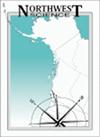哥伦比亚河下游潮汐淡水湿地的鱼类群落
IF 0.5
4区 环境科学与生态学
Q4 ECOLOGY
引用次数: 1
摘要
摘要我们沿着潮汐影响的空间梯度调查了哥伦比亚河浅湿地的鱼类物种丰富度、群落组成、密度和多样性。我们的研究结果揭示了鱼类群落组成、本地和非本地鱼类的比例以及潜在的幼年鲑鱼竞争对手和捕食者的出现等方面的不同季节和空间模式。我们观察到,随着与哥伦比亚河口距离的增加,物种丰富度和多样性增加。非本土物种的比例也有所增加,在哥伦比亚河下游的城市地区尤其高。物种丰富度、密度和非本地物种比例在夏季较高,与水温呈正相关。幼年鲑的密度在春季最高,而在非本地鱼类种类最丰富的夏季,鲑基本上不存在。正如气候变化所预期的那样,未来气温的升高将有利于温水物种的进一步扩张,可能会改变食物网的动态,并对鲑鱼和其他本地鱼类种群产生不可预测的影响。本文章由计算机程序翻译,如有差异,请以英文原文为准。
Fish Communities in the Tidal Freshwater Wetlands of the Lower Columbia River
Abstract We investigated fish species richness, community composition, density, and diversity along a spatial gradient of tidal influence in the shallow wetlands of the Columbia River. Our findings revealed distinct seasonal and spatial patterns in fish community composition, proportions of native and non-native fish species, and occurrence of fish that are potential juvenile salmon competitors and predators. We observed increased species richness and diversity with increased distance from the mouth of the Columbia River. Proportions of non-native species increased as well, and were especially high near the urban areas of the lower Columbia River. Species richness, density, and proportion of non-native species were higher during the summer months and positively correlated with water temperature. Juvenile salmonid density was highest in the spring, and salmonids were largely absent in the summer when non-native fish species were most abundant. Future increases in temperature, as expected with climate change, will favor further expansion of warm-water species, likely changing food web dynamics and having unpredictable effects on salmonids and other native fish populations.
求助全文
通过发布文献求助,成功后即可免费获取论文全文。
去求助
来源期刊

Northwest Science
环境科学-生态学
CiteScore
1.30
自引率
0.00%
发文量
23
审稿时长
>36 weeks
期刊介绍:
The pages of Northwest Science are open to original and fundamental research in the basic, applied, and social sciences. All submissions are refereed by at least two qualified peer reviewers. Papers are welcome from authors outside of the Pacific Northwest if the topic is suitable to our regional audience.
 求助内容:
求助内容: 应助结果提醒方式:
应助结果提醒方式:


